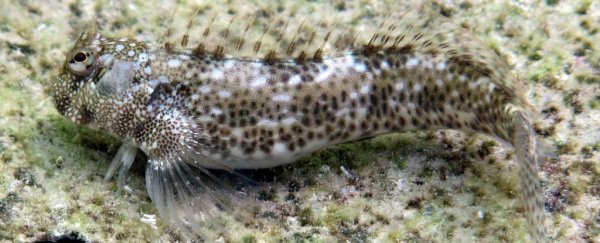There are fish on our planet right now that are evolving to live on land, and a new study shows they are spurred on by predators in the water.
It's a pretty big deal for a little fish - moving from the familiar waters of the ocean to the dry and rocky shoreline. The first land-dwelling creatures evolved some 390 million years ago, but there is debate over why they bothered to flop ashore at all.
Potential reasons include spotting better food on land and going after it, escaping unpleasant fluctuations in water quality, or jumping onto land to get away from underwater predators. A recent study shows the latter hypothesis has some merit.
Biologists have found that four species of blennies - a type of small tropical fish - have independently developed an 'amphibious lifestyle', which means they divide their time between living underwater and hanging out on the shore.
These blennies are found in the tropical waters around Rarotonga, the largest of the Cook Islands in the South Pacific Ocean. It's one of few places in the world where more than one species of fish has moved to hang out on land for significant periods of time.
"Our study of blennies on Rarotonga is the first to examine the pressures driving fish out of the water," says evolutionary ecologist Terry Ord from the University of New South Wales in Australia.
Researchers watched three species of these blennies to gather clues on what might have pushed them ashore. The fish would swim in coastal rock pools at low tide, but move further up on land when the tide was high.
Even amphibious blennies still need water to breathe, though. When they're jumping around the coastal rocks, they keep their gills wet in whatever ocean spray is available in rock crevices.
Blennies have many enemies in the water. They are readily eaten by coral reef fish such as flounders, groupers, wrasses and moray eels.
Researchers measured the abundance of these predators in relation to tidal changes, and found that at high tide - when the blennies scampered up the rocks - there were indeed more dangers abound in the water.
"Life is less hostile on the rocks, with birds their main worry," says Ord.
Next up, the team needed to test the hypothesis that birds were less of a problem than underwater enemies. To measure the frequency of attacks in the places where blennies hang out, the scientists had to hunker down for a crafting afternoon.
They made 249 highly realistic blenny fish from coloured plasticine, and scattered them both underwater and above the high tide mark for three to eight days. The fake blennies ashore fared much better than their underwater counterparts, with relatively few bird strikes.
That's not entirely surprising, given that South Pacific islands tend to have few predators on land, which makes it particularly appealing for blennies to climb ashore. And it's a great clue of evolutionary drivers.
"If you never look over the fence, you'll never know that the grass is greener," Ord told Alice Klein at New Scientist.
"However, if you're forced to the other side to escape something, you may then realise it has additional benefits and want to stay there and adapt."
Previous research by Ord and his colleague Georgina Cooke has already showed that fish have evolved to live on land much more frequently than you'd think.
"A fish out of water might seem an extraordinary thing, but in fact it is quite a common phenomenon," Ord said last year.
"Amphibious behaviour has evolved repeatedly in a wide diversity of present day fish, and the move onto land does not appear to be as difficult as has been presumed."
Of course, it would be difficult for us humans to observe the entire evolutionary process of these blennies as they go from an amphibious lifestyle to staying on dry land for good, if such a day comes.
But the study gives us a rare glimpse into the ecological processes that once drove our very own ancestors to explore new environments, leading to the evolutionary adaptations that we carry in our bodies to this day.
The research was published in The American Naturalist.
UNSW Science is a sponsor of ScienceAlert. Find out more about their world-leading research.
